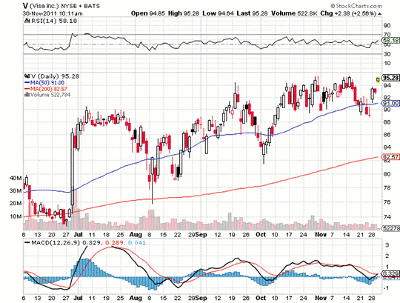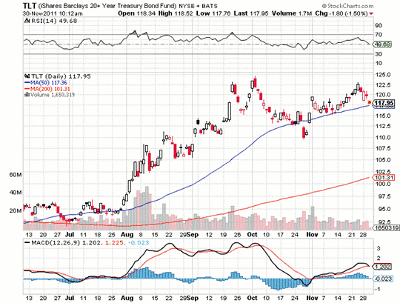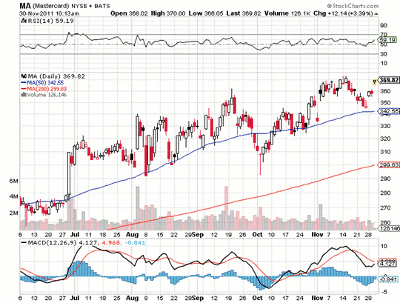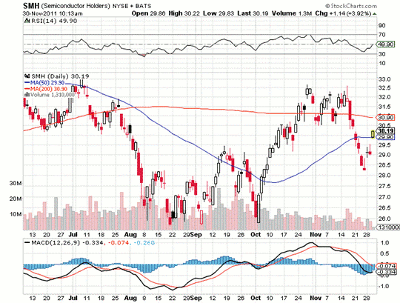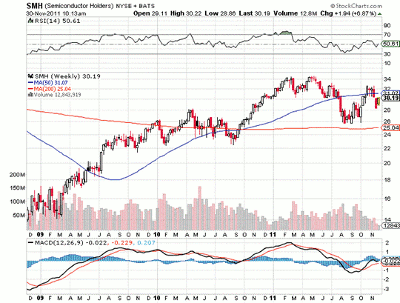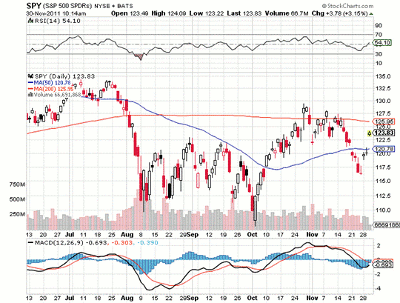Five contributors to InvestorPlace.com give us five option trading ideas for the final month of 2011.
Thanksgiving week came and went without providing the uptick that many traders had hoped to see. And it remains to be seen whether Santa Claus brings us a year-end rally or if he’s following Tom Turkey’s lead in choosing this particular year to take a vacation.
Whatever happens in the markets this December, be sure to keep “goosing up your trading gains” at the top of your to-do list, right up there with your holiday shopping, feast preparing and home decorating.
Black Friday, and every day thereafter until the holiday music stops, brings one opportunity after another for you to spend money. And of course, some of the best bargains you’ll find are in the options markets, so use some of your savings to pick up something special to make your portfolio shine!
But unlike in the stores, going shopping for options can also mean getting paid to make trades – no need to make any returns or exchanges because profits are always a perfect fit!
Today some of our top options experts have decided to share with you their favorite trades for the rest of the year. Let’s take a look at them now.
Trade #1: Visa (V)
Recommended by John Jagerson, SlingShot Trader
If you’re looking for a way to profit this holiday season, all you have to do is focus on consumers’ wallets—or what they are whipping out of them every time they buy a gift.
That’s right, if you want to cash in, invest in plastic.
Visa (V) has been steadily growing its annual revenue and earnings per share, and this holiday season is bound to add to the growth. Plus, Visa has made shareholders happy with recent dividend and share-buyback increases.
We anticipate Visa will see a nice holiday bounce off of its support level at $90, which will help it challenge its recent highs of $95. With that in mind, we recommend buying the V January 95 calls for a maximum price of $3.50.
Here’s a recent daily chart:
NEXT: Trade #2: iShares Barclays 20+ Year Treasury Bond Fund
|pagebreak|Trade #2: iShares Barclays 20+ Year Treasury Bond Fund (TLT)
Recommended by Ken Trester and Jeff Carter, Maximum Options
The iShares Barclays 20+ Year Treasury Bond Fund (TLT) is an exchange traded fund (ETF) that replicates the movement of long-term US Treasury bonds. While we believe the longer-term outlook for Treasury bonds and interest rates is negative, that currently is not the case as traders and institutions continue to pull money out of Europe and anything else that carries financial risk.
Here’s a recent daily chart:
Treasuries are perceived to be “risk free,” so they are beneficiaries of this. And for a reduced-risk way to play T-bonds, we recommend using a put credit spread to put money in your pocket from the moment you make the trade. Specifically, you can “sell to open” the TLT Dec 115 puts while you simultaneously “buy to open” the TLT December 111 puts for a net spread credit of 30 cents or higher.
This position generates a 7.5% return on margin (90% annualized). The maximum risk is $370 per contract ($115 – $111 = $4 spread; $4 – $0.30 credit = $3.70, or $370 a contract).
A put credit spread is a bullish position in which you want the stock price to stay above the upper strike price of the spread. So, be sure to use an auto-stop order to close this position if TLT trades below $115 prior to December options expiration and you do not want to buy the ETF.
If you do not close the position and the TLT December 115 put expires in the money, you will be obligated to buy 100 shares of the fund at $115 per share for each credit spread contract you open… not bad for an ETF that’s currently trading at $120!
NEXT: Trade #3: MasterCard
|pagebreak|Trade #3: MasterCard (MA)
Recommended by Jim Woods, OptionsZone Expert
On Black Friday, shoppers shed conventional wisdom about how they weren’t supposed to do much shopping, and the result was record sales. Total spending over the four-day weekend reached $52.4 billion, up 16% from the $45 billion spent last year.
Convention continued to be swept aside on Cyber Monday, as a record number of online shoppers clicked their way to a 33% year-over-year jump in US sales.
What do so many of these transactions have in common? They were all paid for via credit card, and that’s great news for card issuer MasterCard Inc. (MA).
If we continue to see stellar holiday retail sales, it may mean more upside for MA shares, and that could mean big holiday cheer if you buy the MA January 360 calls at the market.
Here’s a recent daily chart:
NEXT: Trade #4: Semiconductor HOLDRS
|pagebreak|Trade #4: Semiconductor HOLDRS (SMH)
Recommended by Serge Berger, The Steady Trader
We’ve had a good couple of days in the markets, and with immediate-term risk assets being quite oversold, the bounce we are seeing may have further to go.
Soon, the question will become whether this bounce leads to performance-chasing (and hence a rally) in risk assets by fund managers, or whether the global growth slowdown and European debt issue will weigh even more heavily in the markets.
Right now, with volatility elevated, my trade idea involves selling options. In that case, I would like to sell far-out-of-the-money calls, or call spreads, on the Semiconductor HOLDRS ETF (SMH).
The semiconductor stocks often act as a leading indicator to global equities, and SMH’s recent selloff along with the market started at the resistance point at its 200-day simple moving average.
If global growth is to slow, then semiconductor investing should also cool somewhat…and charts like copper and the inverted yield curves all over the world are also confirming slowing growth.
On a weekly chart, SMH, along with the PHLX Semiconductor Index ($XSOX), is developing a major two-year-long head-and-shoulders pattern which, if it works out, would have a final price target near the 2008 lows.
So, in order to enter the trade, we need to see SMH up somewhere between $30 or $31 (it’s at $29 and change, as of this writing), and we would then want to sell calls at least two months out (February or May) and about 5%-10% out of the money.
When selling options, your broker will require you to have a margin account, so be sure to check with him or her before making this or any option-selling trade.
Alternatively, and especially if SMH gets to between $31 and $33, we would also be happy to buy puts, as volatility would have come down. We would then buy May at-the-money puts.
NEXT: Trade #5: SPDR S&P 500
|pagebreak|Trade #5: SPDR S&P 500 (SPY)
Recommended by Adam Warner, Options Volatility Trading
On August 8, the SPDR S&P 500 (SPY) traded in an enormous range with a high near $120 and a low near $112. It set the tone for a very volatile August, and a relatively active autumn overall.
But here’s a dirty little secret: Things haven’t actually changed much since then.
SPY breached to lows of that day in early August and then proceeded to rally to the $128 area before settling back near $120 again. The market seems very volatile, mainly because we open with some relatively large gaps over and over again. But net-net, we’re churning more than anything else.
As such, I like the iron condor in SPY. To establish this position, you would sell the December quarterly 123-126 call spread and the 115-112 put spread for a total combined credit of $1.75.
Think of this trade as entering both a bear call spread and a bull put spread. With both, you collect a credit upfront so you put more money in your pocket right away. It’s also a lower-risk way of playing a security (or, in this case, a market) that’s going nowhere.
The market will break out at some point; I’m just betting with defined risk/reward that it doesn’t happen in a big way before year-end.
By InvestorPlace.com contributors
Find all five contributors at InvestorPlace.com

